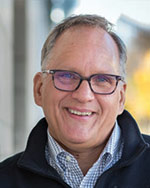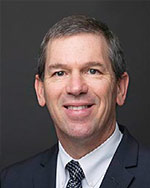Searching for solutions to the rural opioid crisis
 John A. Gale, Maine Rural Health Research Center senior research associate  Michael Meit, NORC Walsh Center for Rural Health Analysis co-director  Tim Putnam, Margaret Mary Health CEO and NRHA president |
Solving the rural opioid crisis starts with bringing awareness to a complex problem. It means difficult conversations between patients and providers, neighbors, family, and colleagues. Finding a way for rural communities to move forward requires collaboration from partners across health care, law enforcement, industry, and community organizations.
A layered and challenging problem
Opioid use takes many forms — teenagers raiding their parents’ medicine cabinets for recreational drugs, factory and farmworkers coping with debilitating work injuries, or older adults living with chronic pain. Misuse of prescription pain relievers such as OxyContin and Vicodin has spiraled into addictions to synthetic opioids such as fentanyl and the illegal drug heroin.
Although opioid misuse spans all ages and socioeconomic groups, the impacts of this crisis are different from one rural region to another. “The driving factors vary from one community to the next, but it’s usually a combination of economic, social, and geographic disparities,” explains John A. Gale, Maine Rural Health Research Center senior research associate and NRHA Rural Health Congress chair. “When there’s poverty, isolation, few opportunities for the future, higher rates of chronic disease, and high rates of physical injury, rates of substance misuse may be higher, too.”
“We’re seeing rapid increases in opioid overdose mortality rates over time, particularly in regions such as Central Appalachia and the Northeast,” says Michael Meit, NORC Walsh Center for Rural Health Analysis co-director and 2019 NRHA Outstanding Researcher Award recipient. “Rates also appear to be spiking with Native American populations, which also deserve focused attention.”
“Many communities experiencing high rates of overdose have shared characteristics, such as associations with high injury-prone industries and high disability status,” Meit notes. “Still, there are some protective factors that we don’t fully understand — and that is the next phase of our work.”
“We know the problem exists in our communities,” says Tim Putnam, Margaret Mary Health CEO and NRHA president. “The question is how to get away from working in isolation and come together to figure out how to best deploy programs and resources to fix it.”
Multiple solutions provide hope
Rural communities need a variety of strategies for tackling the problem of opioid misuse. According to Meit, the response should be “multi-pronged,” utilizing preventive care and treatment interventions that reflect and respect local culture and norms. “We need to be aware that each community is different — but also realize the potential in common solutions that have been proven effective,” Gale says. “Let’s look at how we can connect the dots across systems of care to maximize our resources.”
1. Reducing the flow of opioids.
Lowering prescription rates is an important part of the solution, as it prevents a new generation of individuals from becoming exposed to and potentially dependent on opioids. “Reducing opioid prescriptions is an important piece of the long-term solution, but needs to be done in concert with accessible, affordable, and high-quality treatment,” Meit says.
The medical community is working to prevent opioid dependence and misuse in a number of ways, including:
- use of local anesthetic solutions to lessen the need for opioids during surgery.
- alternative therapies and programs for pain.
- Oxy-free emergency departments that don’t prescribe or refill opioids as a first line response to acute injuries.
- systems for tracking opioid prescriptions so providers and pharmacists can identify patients who have multiple sources of the drug.
- educating patients about proper opioid use and disposal.
2. Opioid reversal drugs.
Opioid reversal drugs such as naloxone can save lives by reversing the effects of opioid overdose. The drugs can be administered by police officers, EMTs, and others in the community. “Naloxone is a critical part of harm reduction, which is why it’s important to make it available and relatively inexpensive for those who need it,” Gale says.
3. Treatment programs.
Rural hospitals are working to offer treatment programs by pooling resources and partnering with other community-based programs. “Through a grant, we are able to offer an intensive outpatient detox program that has been successful in moving people to active and functioning lives,” Putnam says.
Research suggests that medication-assisted treatment (MAT), which combines medication and counseling, is an effective, evidence-based treatment modality for individuals with opioid use disorder — but the time and costs involved can make it difficult for patients in rural areas to access and follow through with the program. “Ensuring access to high-quality MAT is an important component to community response efforts,” Meit says.
4. Pain management programs.
Pain management programs help people deal with chronic pain without relying on habit-forming pills, which can prevent opioid addiction and relapse. “Two rural hospitals in Maine identified a significant trend in patients coming to the ER experiencing dental pain. By creating pain management programs targeted for patients with dental pain, they were able to successfully reduce the use of opioids,” Gale says.
5. Peer support.
Groups such as Alcoholics Anonymous and Narcotics Anonymous offer 12-step programs to help those struggling with addiction. Peer recovery coaches also provide a low-cost way to open the lines of communication for patients coming into a hospital or clinic with substance use issues. “We use peer recovery coaches to help people who come into the ER with addiction issues,” Putnam says. “They can also be helpful in direct care, mentor groups, and peer groups.”
6. Community partnerships.
Treating addiction takes a village, with the local health care system, mental health services, criminal justice system, social welfare organizations, and employers all working together. “Partnering with criminal justice helps us make important progress in the areas of mental health and addiction,” Putnam says. “Having affordable housing, food security, and employment opportunities also make a big difference.”
“The Angel Project, which was started in Massachusetts in 2016, is a plan that offers treatment instead of jail time for those who voluntarily come forward to turn in their drugs,” Gale says. Today more than 100 police departments have modeled their own versions of the initiative.
7. Overcoming stigma.
One of the misconceptions about opioid use and mental health is that it’s treated as a crime or character flaw. “We have to treat opioid use as a chronic disease, and we can’t blame the victims,” Gale says. “It’s really a case of changing perceptions so people suffering from substance use disorders can get help in a way that retains their humanity.”
Many of us know someone who struggles with opioid use, but it’s easy to ignore or downplay the problem until it’s too late. “We need to help our neighbors, friends, and colleagues get judgement-free treatment and overcome the stigma associated with it,” Gale says. “These folks deserve a second chance to get their lives back.”
Rural insight on next steps
“I’m confident that rural communities can leverage their strengths and creativity in ways that will ultimately improve outcomes,” Meit says. “One of the greatest assets of rural communities is strong levels of cross-sector partnership to solve problems. We need to build on this history of rural collaboration to share resources and to create and implement dynamic solutions to our challenges.”
According to Meit, a history of local collaboration shows that rural Americans can provide a vital service to the country as a whole. Ultimately, he says, “I believe that rural communities will be the leaders in identifying how to address the opioid and substance misuse crisis.”
Your chance to learn about rural opioid epidemic solutions directly from these NRHA members and more experts from across the U.S. is at NRHA's Rural Health Clinic and Critical Access Hospital Conferences Sept. 17-20 in Kansas City. The deadline for our biggest discounts on registration is Aug. 16.
